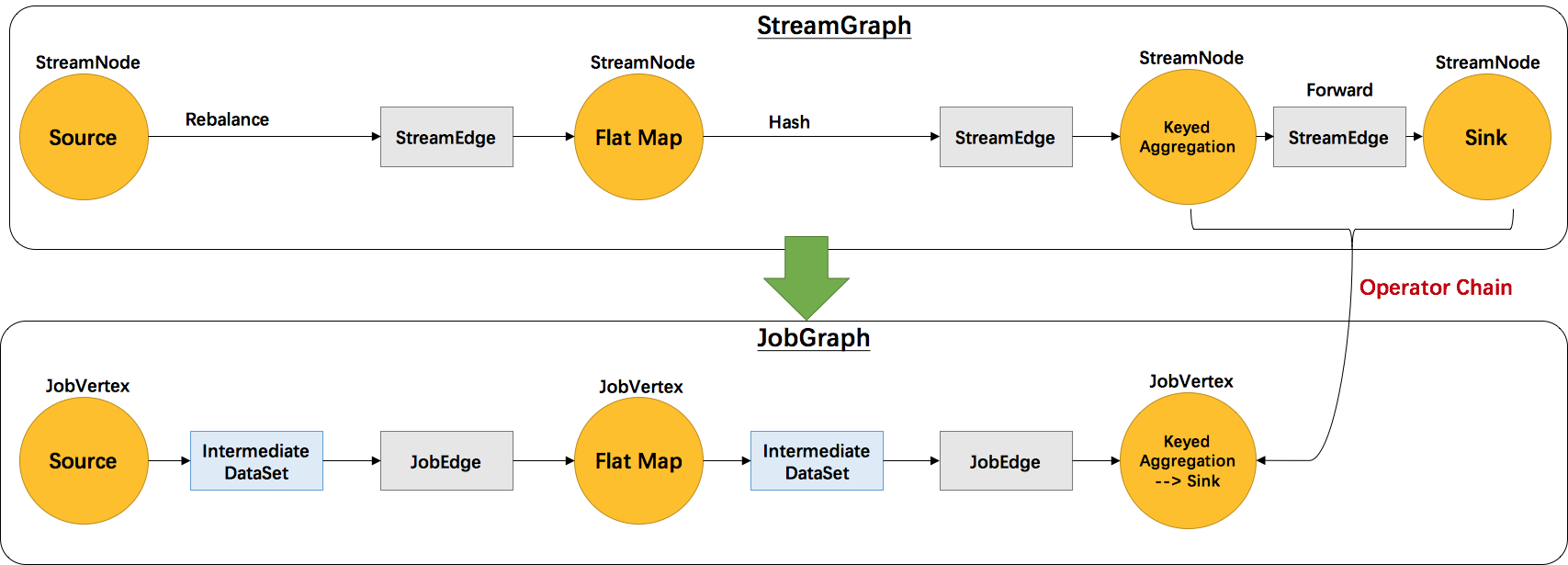继前文Flink 原理与实现:架构和拓扑概览中介绍了Flink的四层执行图模型,本文将主要介绍 Flink 是如何将 StreamGraph 转换成 JobGraph 的。根据用户用Stream API编写的程序,构造出一个代表拓扑结构的StreamGraph的。以 WordCount 为例,转换图如下图所示:
StreamGraph 和 JobGraph 都是在 Client 端生成的,也就是说我们可以在 IDE 中通过断点调试观察 StreamGraph 和 JobGraph 的生成过程。
JobGraph 的相关数据结构主要在 org.apache.flink.runtime.jobgraph 包中。构造 JobGraph 的代码主要集中在 StreamingJobGraphGenerator 类中,入口函数是 StreamingJobGraphGenerator.createJobGraph()。我们首先来看下StreamingJobGraphGenerator的核心源码:
public class StreamingJobGraphGenerator { |
StreamingJobGraphGenerator的成员变量都是为了辅助生成最终的JobGraph。createJobGraph()函数的逻辑也很清晰,首先为所有节点生成一个唯一的hash id,如果节点在多次提交中没有改变(包括并发度、上下游等),那么这个id就不会改变,这主要用于故障恢复。这里我们不能用 StreamNode.id来代替,因为这是一个从1开始的静态计数变量,同样的Job可能会得到不一样的id,如下代码示例的两个job是完全一样的,但是source的id却不一样了。然后就是最关键的chaining处理,和生成JobVetex、JobEdge等。之后就是写入各种配置相关的信息。
// 范例1:A.id=1 B.id=2 |
下面具体分析下关键函数 setChaining 的实现:
// 从source开始建立 node chains |
每个 JobVertex 都会对应一个可序列化的 StreamConfig, 用来发送给 JobManager 和 TaskManager。最后在 TaskManager 中起 Task 时,需要从这里面反序列化出所需要的配置信息, 其中就包括了含有用户代码的StreamOperator。
setChaining会对source调用createChain方法,该方法会递归调用下游节点,从而构建出node chains。createChain会分析当前节点的出边,根据Operator Chains中的chainable条件,将出边分成chainalbe和noChainable两类,并分别递归调用自身方法。之后会将StreamNode中的配置信息序列化到StreamConfig中。如果当前不是chain中的子节点,则会构建 JobVertex 和 JobEdge相连。如果是chain中的子节点,则会将StreamConfig添加到该chain的config集合中。一个node chains,除了 headOfChain node会生成对应的 JobVertex,其余的nodes都是以序列化的形式写入到StreamConfig中,并保存到headOfChain的 CHAINED_TASK_CONFIG 配置项中。直到部署时,才会取出并生成对应的ChainOperators,具体过程请见理解 Operator Chains。
总结
本文主要对 Flink 中将 StreamGraph 转变成 JobGraph 的核心源码进行了分析。思想还是很简单的,StreamNode 转成 JobVertex,StreamEdge 转成 JobEdge,JobEdge 和 JobVertex 之间创建 IntermediateDataSet 来连接。关键点在于将多个 SteamNode chain 成一个 JobVertex的过程,这部分源码比较绕,有兴趣的同学可以结合源码单步调试分析。下一章将会介绍 JobGraph 提交到 JobManager 后是如何转换成分布式化的 ExecutionGraph 的。

